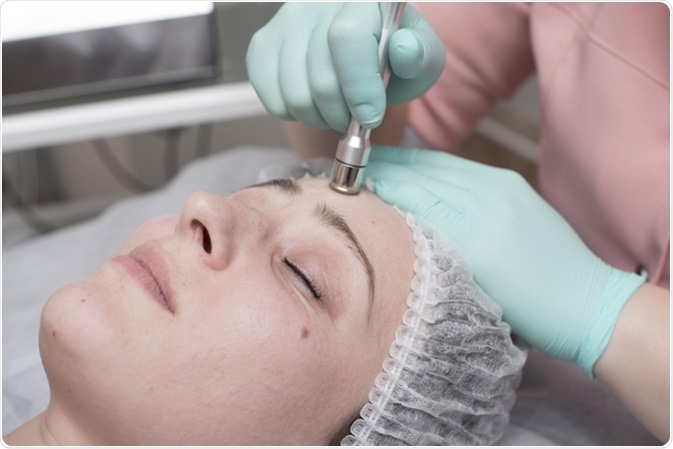Dermabrasion is a minimally invasive surgical procedure in which the most superficial layers of the epidermis are removed to smooth the skin. It is typically performed in the doctor’s office or outpatient clinic, by a plastic or dermatologic surgeon.
The procedure is painful and therefore it is performed under local anesthesia. Sedation or even general anesthesia may be necessary if a more complicated surgery is planned, and especially if the patient is nervous or a large area is to be treated. Small parts are abraded at a time.
There are a range of devices used (including diamond fraises, burrs, rasps, or sandpaper) to carefully abrade the top layers of the skin until normal healthy epidermis is reached. Following its completion, the skin is smeared with petroleum jelly or antibiotic creams to keep it from drying out, and encourage it to heal with minimal or no scarring or scab formation.

Facial dermabrasion. Image Credit: Vita Sun / Shutterstock
Care during the period of recovery will optimize the cosmetic result by preventing hyper- or hypopigmentation due to excessive inflammation. Most of the people prefer to stay at home during recovery period, while return to work can be expected in approximately two weeks.
Indications for Dermabrasion
Dermabrasion is performed in patients with any of the following indications, though the list is not exhaustive:
- Skin growths or tags as a result of aging skin
- Fine wrinkles and lines on the face
- Premalignant tumors
- Acne scars
- Facial scarring following trauma or surgery
- Actinic elastosis and photoaging
Supplementary treatment of the skin may be necessary in many of these patients, which is often performed using lasers, chemical peeling, or injections of botulinum toxin or dermal fillers to relax or fill out the skin wrinkles.
Risks and Side Effects
Dermabrasion is a surgical procedure and the complications of anesthesia may occur, as in any other patient. These include breathing difficulties and hypersensitivity to medications, bleeding from the surgical site, or infection entering through the abraded skin.
Hyper- or hypopigmentation of the skin may occur, which may persist over the long term. This could cause disfigurement of the treated skin by darker, lighter or pink patches. Hyperpigmentation is more likely with dark-skinned people. Scarring may also occur, though rarely.
The skin looks and feels inflamed making normal activities such as eating or talking more difficult. The swelling may take 2-3 weeks to subside. The treated area may ache or burn for some days or weeks, but this is usually treatable with pain relievers.
The healing skin may look a little pinker than normal, and feel itchy and swollen for several weeks during which it should be cared for in accordance with the discharge instructions.
This period should be marked by abstinence from contact sports and ball sports such as baseball, for at least 4-6 weeks. Chlorinated water should be kept away from contact with the area. It may be wise to abstain from alcohol for a few weeks since it can cause immediate flushing due to vasodilatation. Shaving and sun exposure should also be avoided, the latter for up to one year.
During the period of healing, it may be advisable to wear hypoallergenic make up to hide the discoloration. If the skin remains inflamed even after it begins to heal, it may be an early indication of scar formation, thus medical treatment may be required.
References
Further Reading
Last Updated: May 25, 2023